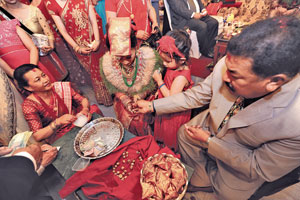
Remembering the mouthwatering delicacy from childhood, a unique mix of specially cooked rice combined with sugar and butter.
Ask a man about haja, and he’ll tell you to ask a woman about it! Not because he cannot be bothered by the preparation of food items, but because he’s more interested in the end product of haja – chyang or raksi.
This unique rice delicacy is traditionally prepared when the women of the house start the tedious and meticulous process of brewing alcohol. And preparing it has some really interesting and difficult procedures. After boiling hot water in a phosi, you put the haasi on top, which is a big pot with holes on the bottom. The bottom is covered with enough hay to make a good base followed by green leaves. Then you pour the required amount of rice, and cover the mouth of the haasi with a lid filled with water. Thus, the famed steamed rice is prepared.
For those who have consumed haja, they cannot stop praising it. There’s something delicious about the rice made this way. Before the idea of buffet parties really picked up, guthi gatherings and other social functions would serve a scrumptious meal of haja. It is easier to prepare than normal rice. Perhaps what has slowly made its existence fade from the popular culinary choice is the difficulty and the heavy utensils it needs.
Though taichin rice is a favorite for haja, people also use other types of rice for it. And even the method of preparation have changed. Finding a phosi or a haasi in a normal household is difficult these days, so using a steamer is a much easier option.
Those who cherish the memory of haja, do so mainly for its amazing mix with clarified butter and sugar. The combination further accentuates the taste of the rice, making it a memorable treat. And more so the kids. The rice mixture is rolled into little bite sized and given to little children to enjoy. Rice had never been so tasty!










